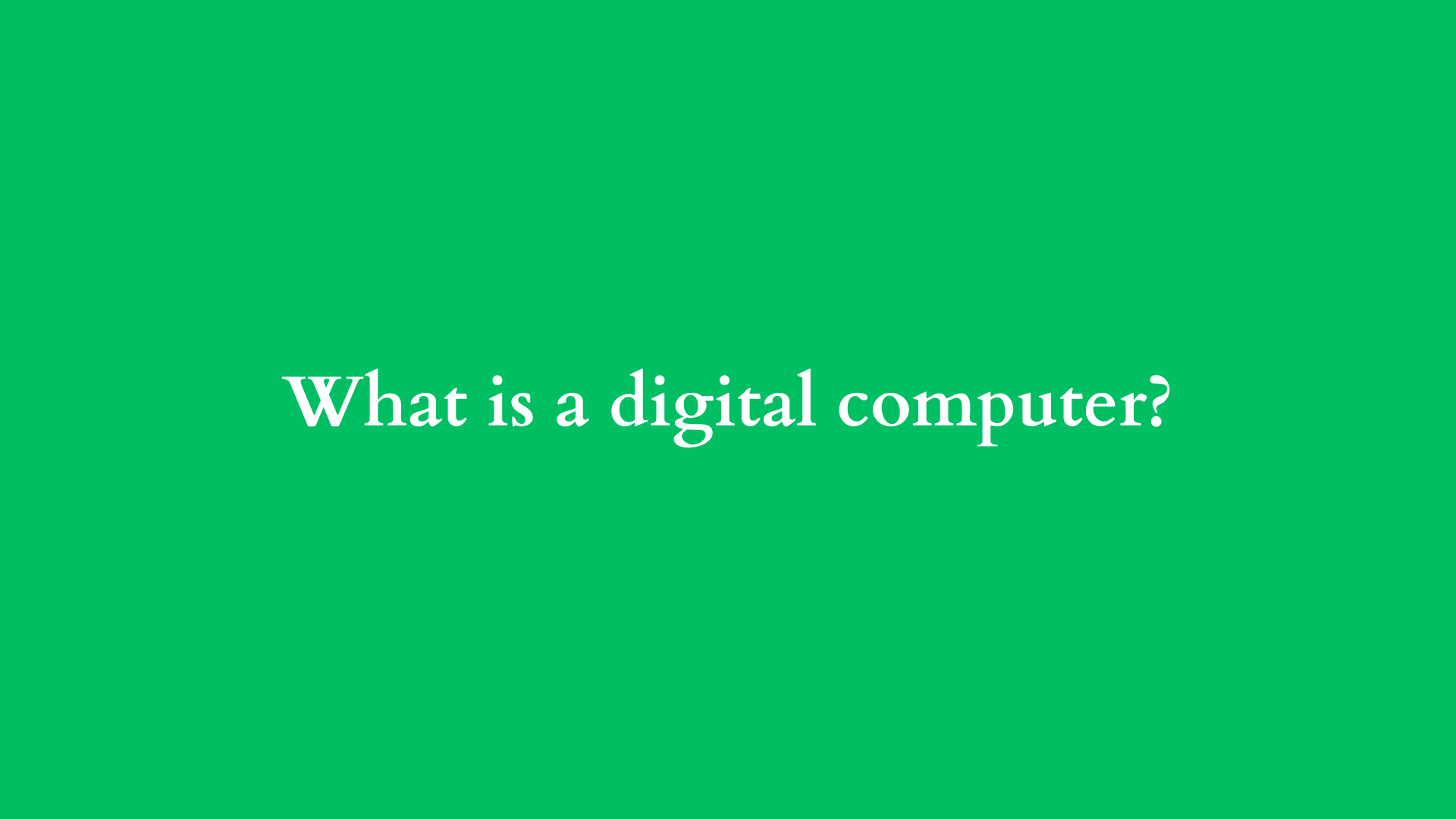Understanding Digital Computers: A Comprehensive Overview
In an era where technology is at the forefront of our daily lives, the term “digital computer” has become a familiar part of the lexicon for many. From smartphones and laptops to servers that manage vast quantities of data, digital computers enable the functioning of countless applications and services that we often take for granted. This blog post aims to elucidate what a digital computer is, how it operates, its historical context, and its impact on modern society.

Defining Digital Computers
At its core, a digital computer is an electronic device that processes data in a binary format—using the digits 0 and 1. Each instruction, data point, and output is represented in this binary code, allowing the computer to execute a wide array of tasks ranging from simple calculations to complex simulations. Unlike analog computers, which process data in a continuous manner, digital computers work with discrete values. This inherently binary nature underpins their design and functionality.
Key Characteristics of Digital Computers
- Binary System: Digital computers operate using the binary number system. Each binary digit (or bit) can exist in one of two states: 0 or 1. These bits serve as the fundamental building blocks for representing all types of data, including numbers, letters, images, and sounds.
- Data Processing: Digital computers can perform various operations such as arithmetic (addition, subtraction, multiplication, division) and logic (AND, OR, NOT) on the binary data. This capability allows for complex problem-solving and data manipulation.
- Storage: Digital computers utilize various forms of memory to store data and instructions temporarily or permanently. Components such as Random Access Memory (RAM) provide fast, temporary storage for active tasks, while Hard Disk Drives (HDD) or Solid State Drives (SSD) serve to store data long-term.
- Programmability: One of the most significant features of digital computers is their programmability. By providing a set of instructions (software), users can dictate what tasks the computer performs, making it versatile and adaptable for various applications.
- Speed and Accuracy: Digital computers can process vast amounts of data at incredible speeds, performing millions of operations per second with a high degree of accuracy. This efficiency makes them invaluable for tasks that require rapid data processing, like financial transactions or simulations.
Historical Context
The evolution of digital computers can be traced back to the early 20th century. While computing as a concept can be credited to early mechanical devices like the abacus or mechanical calculators, the first electronic digital computers emerged during World War II. The Colossus, used by the British to break German codes, and the ENIAC, which performed calculations for the war effort, were among the pioneering machines that paved the way for future developments.
The post-war era saw the introduction of transistors, which replaced vacuum tubes and greatly enhanced the performance and reliability of digital computers. The invention of the microprocessor in the 1970s further revolutionized computing, leading to the emergence of personal computers in the 1980s. Companies like IBM and Apple played crucial roles in bringing digital computing into homes and offices, fundamentally altering the landscape of personal and professional life.
Types of Digital Computers
Digital computers come in various forms, each serving distinct purposes. Understanding these variations is essential for appreciating the breadth of applications of digital technology.
- Personal Computers (PCs): Widely used in homes and offices, PCs are designed for individual users. They are versatile machines capable of handling everything from word processing and gaming to complex software applications.
- Workstations: Workstations are more powerful than personal computers, with enhanced processing capabilities tailored for tasks such as graphic design, scientific simulation, and software development.
- Servers: Servers are specialized computers that provide services to other computers over a network. They are fundamental to internet infrastructure, hosting websites, managing databases, and facilitating cloud computing.
- Embedded Systems: These computers are integrated into other devices, such as automobiles, appliances, and industrial machinery. They are designed to perform specific tasks and often operate in real-time.
- Supercomputers: Supercomputers are the most powerful type of digital computer, capable of processing billions of calculations per second. They are typically used in research, complex simulations, and data analysis across diverse fields, including climate modeling, genomics, and physics.
- Quantum Computers: Though still in developmental stages, quantum computers are being designed to leverage the principles of quantum mechanics, offering the potential for exponential increases in processing power and the ability to solve problems deemed unsolvable by classical digital computers.
The Impact of Digital Computers on Society
The proliferation of digital computers has led to profound changes in various sectors and everyday life. Here are some notable impacts:
- Communication: Digital computers have transformed communication channels. Email, social media, and instant messaging allow for rapid interactions across the globe, shrinking distances and enabling instant connectivity.
- Education: The educational landscape has shifted significantly with digital technologies. E-learning platforms, virtual classrooms, and access to vast online resources have democratized knowledge and made education more accessible.
- Healthcare: Digital computing plays a crucial role in healthcare through electronic health records (EHR), telemedicine, diagnostic tools, and treatment planning. The ability to analyze large data sets has also led to advancements in personalized medicine.
- Economy: The digital economy has emerged as a powerful force, reshaping business operations, marketing strategies, and consumer behavior. E-commerce, digital payments, and data analytics have redefined the marketplace.
- Automation and Artificial Intelligence: Digital computers are central to the development of automation technologies and artificial intelligence (AI). From manufacturing robots to voice-activated assistants, the influence of digital computing extends into diverse industries, raising questions about the future of work.
Conclusion
In conclusion, digital computers represent a cornerstone of contemporary society, influencing myriad aspects of life and work. By processing data in binary format, they offer unparalleled flexibility, speed, and accuracy. Their evolution from basic electronic calculators to sophisticated systems capable of powering entire industries illustrates the remarkable advancements in computing technology over the decades. As we move further into the digital age, understanding digital computers will remain paramount for leveraging their full potential and navigating the increasingly complex technological landscape.
Shop Now






